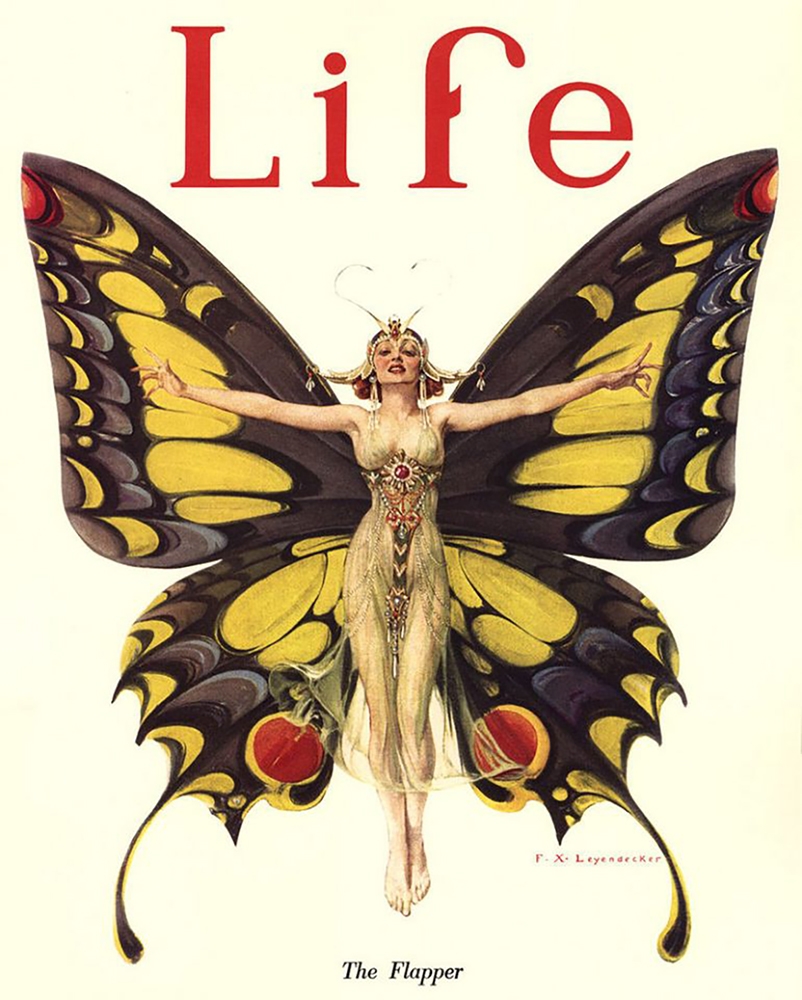Winner of the Fall 2016 StMU History Media Award for
Best Article in the Category of “Culture”
When one thinks of the 1920’s era one immediately thinks about Flappers. A flapper was considered a young woman who was very fashionable. This was a young female who enjoyed life to the fullest, flouting her unconventional standards of behavior and carefree party lifestyle.1 The spirit behind this movement was all about leaving the traditional ways of life behind and transforming into an independent woman.

Before World War I, the concept of femininity was referred to as the Gibson Girl. This term was used to describe these new independent and often well educated women. Gibson girls wore their hair long, pinned up and adorned with beautiful hats. They completed their ensemble by wearing long skirts and blouses that buttoned up to their necks. Despite their feminine appearance, these women were more than capable of doing the same things that men did. Examples of this include activities such as playing sports: skating, golfing, bicycling, tennis. These young ladies did not go out until they were asked properly by a young man who had good intentions and a promise of marrying them. Gibson Girls soon broke away from their traditional ways.2
In 1915, two years before America’s entry into World War I, a famous author by the name of H.L. Mencken introduced the word “Flapper” to the United States. Mencken stated that a flapper was “a woman who consumed music, literature and periodicals voraciously taking her cues for behavior and style from the media in front of her rather than the moral codes of decorum.”3 Another famous author, F. Scott Fitzgerald, famous for his classic novel The Great Gatsby, described the flapper as “lovely, expensive, and about nineteen.” John Held Jr., who was an American cartoonist, emphasized the flapper by drawing young girls wearing unbuckled galoshes that would make a “flapping” noise when walking.4 Despite the many different terms, Flappers were described essentially the same way: they were young girls who enjoyed the party life and had a sense of fashion.
After World War I ended in 1918, many things had changed for the men returning home, particularly the roles and values that women were embracing. The traditional values were gone and in their place came a faster, sleeker, and more daring approach to life. This time period not only ushered in an era of change in values, but it also established a new baseline for what was considered feminine. The Flapper Age was born and it brought with it a new and independent woman. These women smoked, drank, voted, cut their hair into bobs, wore eyeliner, and went to as many parties as they could—enjoying every bit of the social life along the way.5

During the 1920’s, fashion changed drastically due to a very famous designer, Coco Chanel. This woman helped flapper fashion to stand on its own. Typical flapper clothing included a simple sack like dress, which allowed women of all classes to make their own dresses and remain on trend.6 The waist of the dress was dropped to the hipline, and the skirt fell just below the knee. Stockings made of rayon were added and worn over a garter belt. To complete the look, bracelets were added and necklaces ran from the neck to the waist. Cloche hats sat atop their heads and drew the eye into a new hairstyle trend known as the bob.7 The make-up of flappers consisted of a red powder or cream that was used for the lips and cheek, eye-liner, powder for the face, and red lipstick that became very popular.
On January 19, 1919, the Eighteenth Amendment, also known as the Volstead Act, came into effect and gave way to the Prohibition Era in which the sale, production, importation, and transportation of alcohol was banned across the nation.8 This change in the legal system caused the sale and consumption of liquor and alcohol to go underground. The most rebellious thing a flapper could do at this time was to consume alcohol, and these young girls had a reputation for being giddy. The following year, on August 18, 1920, the Nineteenth Amendment was passed and women now had the right to vote.9 In 1924, the first radio launched more than 600 commercial channels around the U.S. The radio at the time was the social media on the flapper life. Many young girls swarmed the theaters to see the image of the flapper on screen. Famous actress Clara Bow, starred in the “Flapper” and made the look iconic.
On December 2, 1927, Henry Ford invented the Model A vehicle and car sales increased.10 Women were now owners of vehicles, and the car became a lifeline to a world full of excitement for the flapper in particular. With no one to stop them, they were free to come and go as they pleased. Liberated women were now able to go out and enjoy dancing during this era that was the Jazz Age. The most popular thing for a flapper to do was to go to a nightclub where she would drink, dance, and show off her moves. The era of the Flapper, however, came to an end with the Wall Street Crash of 1929. Many young women lost their jobs and the incomes that had given them such independence.11
Life in the 1920’s left a huge legacy for women to this day. Flappers and the forward-thinking concept of the modern woman is what initiated the change in society for how women were viewed then as well as how they continue to be viewed in present day. With their bold choice in attire, along with their new views and attitudes regarding femininity, both in fashion as well as social conduct, Flappers left behind the old traditional ways and paved the road for a more liberated female.
- Salem Press Biographical Encyclopedia, January 2016, s.v. “Flappers,” by R.L. Smith. ↵
- Kelly B. Sagert, Flappers: A Guide to an American Subculture (Greenwood Publishing Group, 2010), 1-2. ↵
- Brian DiPaolo, Flappers: Issues & Controversies in American History (Infobase Publishing, 2007), 4-5. ↵
- DiPaolo, Flappers: Issues & Controversies in American History, 4-5. ↵
- Soo Hyun Park, Flapper Fashion In the Context of Cultural Changes of America in the 1920’s (CUNY Academic Works, 2014), 1-2. ↵
- Salem Press Biographical Encyclopedia, January, 2016, s.v. “Flappers,” by R.L. Smith. ↵
- Sagert, Flappers: A Guide to an American Subculture, 3. ↵
- Sagert, Flappers: A Guide to an American Subculture, 5. ↵
- DiPaolo, Flappers: Issues & Controversies in American History, 2. ↵
- F.L. Allen, Only Yesterday: An Informal History of the Nineteen Twenties (National Humanities Center, 1931), 5. ↵
- Alan Brinkley, American History: Connecting with the Past Volume 2, 15 edition (New York: McGraw-Hill Education, 2014), 643. ↵




213 comments
Mariah Garcia
I have always heard this era called the roaring 20’s. After reading this article I believe that it definitely was “roaring.” Many changes occurred from the 18th and 19th Amendment passing to Henry Ford inventing the Model A vehicle. But, the most interesting event of this article were the “Flappers.” Women who paved the path for modern day feminism. How it must’ve been to break the norm and be successful with their efforts, the effects of which can still be felt to this day.
Hailey Rodriguez
Ever since the 2013 version of the film, The Great Gatsby was released, I have been obsessed with the 1920s and flappers. I always thought their lavish, party lives were so elegant and wild at the same time. I have, since then, grown an interest in researching and reading more about this era which is why I found this article so interesting. It is crazy to think that women made such a drastic leap into society in such a short period of time. From one decade to another, they were smoking, drinking, partying, driving, dancing and even voting. With the Prohibition and Woman’s Suffrage, is definitely one of the most intriguing.
Gabriela Ochoa
The 20s have always been a fascinating era to me and the flappers play a big part in the 20s and the changes they made for women. This article definitely showed how one change that the women made paved a way for them to make more changes and to inspire more women to grow and become who they wanted to be and not who they were expected to be.
Lamont Traylor
This article is particularly interesting to me because I have always believed that I should have been living around the roaring twenties. As I read the article, I don’t know why but the way that the people dressed and the way that the flappers started to become more free in the way that they dressed and expressed themselves. Something about it spoke to me.
Madeline Torres
It’s amazing how the change of women’s ways changed history in its entirety. This article definitely contained so much history and took me back to the roaring 20s. I really enjoyed this article, it showed how powerful a change in humans or society can make in history. Women these days definitely would have not have the courage to do what they want now if it weren’t for flappers, in my opinion.
Stephanie Silvola
The Flappers paved the way for modern women. Not only was their fashion iconic, but the independence that they carried made themselves attractive. Flappers were able to inspire other women to make moves toward a less conservative lifestyle of women. Women were opressed and treated unfairly compared to men and made it quite difficult to work and vote. With the help of educated, independent-minded Flappers and many other inspiring women, it moved the traditional expecations of women to a more free viewing perspective. This article depicted a decade and the women in it respectfully and amazingly.
Lynsey Mott
I think this article is so important because now days a female is living life to the fullest, they are partying, etc. So in the 1920s having that role was so important. It showed men, like the article said, how they could do what a man could do despite the way they dressed. They left their mark on the world by not acting how society wanted them to at. And I think that to me, is inspirational.
Daniela Martinez
This article presents the true importance of the Flapper movement during the 1920s and beyond. These young women were not only fashionable but were also forward thinking. The Flapper girls were educated and independent which was crucial during this period of time. Women were able to truly indulge themselves in their personal likes as they pleased. The article highlights the significance of the Flapper movement and how it paved the way for a new and more empowered woman during this time.
William Rittenhouse
It makes a lot of sense why women rebelled and sought to reform the idea of a traditional women into something opposite. The culture before them was very traditional in the sense of social life. I have learned that most kids change from the views of their parents as they get older. I think part of the blame goes to the advancement of technology and communications. Our culture has become over-sexualized ever since the flappers came into the picture and in our time it has become so much worse.
Karina Cardona Ruiz
I find it interesting that the Flappers were some of the firsts to stray away from traditional views and expectations of women. I feel that the author did an exceptional job at going in depth on the topic as well as relating it to other events that occurred around this era such as the addition of the 18th and 19th Amendment. I enjoyed how the article started out describing the typical modest woman of the 20’s to the rebellious flapper who went out to party and drink regardless of what people might think.